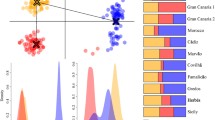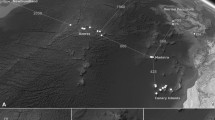Abstract
Reproductive isolation is central to the maintenance of species, and especially in sympatry, effective barriers to prevent interspecific crosses are expected. Host specificity is thought to constitute an effective mechanism for the formation of barriers in different genera of Fungi, but evidence for endophytes is so far lacking. Sexual Epichloë species (Ascomycota, Clavicipitaceae) represent an ideal study system to investigate the mechanisms underlying speciation as mediated by host specificity because they include species complexes with several host-specific taxa. Here, we studied genetic differentiation of three host-specific Epichloë species using microsatellite markers that were newly in silico identified on the genome of Epichloë poae. Among these, 15 were experimentally tested and applied to study an extensive sampling of isolates representing Epichloë typhina infecting Dactylis glomerata and Epichloë clarkii infecting Holcus lanatus from a site with sympatric populations in Switzerland, as well as a reduced sampling of E. poae infecting Poa nemoralis to create a three-taxon dataset. Both principal coordinate analysis and Bayesian clustering algorithm showed three genetically distinct groups representing the three host-specific species. High pairwise F ST values among the three species, as well as sequencing data of the tefA gene revealing diagnostic single nucleotide polymorphisms (SNPs), further support the hypothesis of genetic discontinuities among the taxa. These results provide genotypic evidence of the maintenance of reproductive isolation of the species in a context of sympatry. In silico testing of 885 discovered microsatellites on the genome of Epichloë festucae extend their applicability to a wider taxonomic range of Epichloë.


Similar content being viewed by others
References
Kohn LM (2005) Mechanisms of fungal speciation. Annu Rev Phytopathol 43:279–308. doi:10.1146/annurev.phyto.43.040204.135958
Giraud T, Refrégier G, Le Gac M et al (2008) Speciation in fungi. Fungal Genet Biol 45:791–802. doi:10.1016/j.fgb.2008.02.001
Restrepo S, Tabima JF, Mideros MF et al (2014) Speciation in fungal and oomycete plant pathogens. Annu Rev Phytopathol 52:289–316. doi:10.1146/annurev-phyto-102313-050056
Finlay BJ (2002) Global dispersal of free-living microbial eukaryote species. Science 296:1061–1063. doi:10.1126/science.1070710
Slatkin M (1987) Gene flow and the geographic structure of natural populations. Science 236:787–792
Liti G, Carter DM, Moses AM et al (2009) Population genomics of domestic and wild yeasts. Nature 458:337–341. doi:10.1038/nature07743
Ellison CE, Hall C, Kowbel D et al (2011) Population genomics and local adaptation in wild isolates of a model microbial eukaryote. Proc Natl Acad Sci U S A 108:2831–2836. doi:10.1073/pnas.1014971108
Koufopanou V, Burt A, Taylor JW (1997) Concordance of gene genealogies reveals reproductive isolation in the pathogenic fungus Coccidioides immitis. Proc Natl Acad Sci U S A 94:5478–5482
Dettman JR, Jacobson DJ, Turner E et al (2003) Reproductive isolation and phylogenetic divergence in Neurospora: comparing methods of species recognition in a model eukaryote. Evolution 57:2721–2741
O’Donnell K, Ward TJ, Geiser DM et al (2004) Genealogical concordance between the mating type locus and seven other nuclear genes supports formal recognition of nine phylogenetically distinct species within the Fusarium graminearum clade. Fungal Genet Biol 41:600–623. doi:10.1016/j.fgb.2004.03.003
Fournier E, Giraud T (2008) Sympatric genetic differentiation of a generalist pathogenic fungus, Botrytis cinerea, on two different host plants, grapevine and bramble. J Evol Biol 21:122–132. doi:10.1111/j.1420-9101.2007.01462.x
Peever TL (2007) Role of host specificity in the speciation of Ascochyta pathogens of cool season food legumes. Eur J Plant Pathol 119:119–126. doi:10.1007/s10658-007-9148-2
Stukenbrock EH, Bataillon T, Dutheil JY et al (2011) The making of a new pathogen: insights from comparative population genomics of the domesticated wheat pathogen Mycosphaerella graminicola and its wild sister species. Genome Res 21:2157–2166. doi:10.1101/gr.118851.110
Giraud T (2006) Speciation in parasites: host switching does not automatically lead to allopatry. Trends Parasitol 22:151–152
Leuchtmann A (1992) Systematics, distribution, and host specificity of grass endophytes. Nat Toxins 1:150–162
Schardl CL, Scott B, Florea S, Zhang D (2009) Epichloë endophytes: clavicipitaceous symbionts of grasses. In: Deising HB (ed) The Mycota, vol V, Plant relationships, 2nd edition. Springer, Berlin, pp 275–306
Bultman TL, Leuchtmann A (2009) Biology of the Epichloë–Botanophila interaction: an intriguing association between fungi and insects. Fungal Biol Rev 22:131–138. doi:10.1016/j.fbr.2009.04.003
Scott B (2001) Epichloë endophytes: fungal symbionts of grasses. Curr Opin Microbiol 4:393–398
Western JH, Cavett JJ (1959) The choke disease of cocksfoot (Dactylis glomerata) caused by Epichloë typhina (Fr.) Tul. Trans Brit Mycol Soc 42:298–307
White JF Jr, Bultman TL (1987) Endophyte–host associations in forage grasses. VIII. Heterothallism in Epichloë typhina. Am J Bot 74:1716–1721
Bultman TL, White JF Jr, Bowdish TI, Welch AM (1998) A new kind of mutualism between fungi and insects. Mycol Res 102:235–238
Craven KD, Hsiau P, Leuchtmann A et al (2001) Multigene phylogeny of Epichloë species, fungal symbionts of grasses. Ann Missouri Bot Gard 88:14–34
Schardl CL, Leuchtmann A, Chung KR et al (1997) Coevolution by common descent of fungal symbionts (Epichloë spp.) and grass hosts. Mol Biol Evol 14:133–143
White JF Jr (1993) Endophyte-host associations in grasses. XIX A systematic study of some sympatric species of Epichloë in England. Mycologia 85:444–455
Leuchtmann A, Schardl CL (1998) Mating compatibility and phylogenetic relationships among two new species of Epichloë and other congeneric European species. Mycol Res 102:1169–1182
Leuchtmann A, Clay K (1997) The population biology of grass endophytes. In: Carroll GC, Tudzynski P (eds) The Mycota, vol V, Part B: Plant relationships. Springer-Verlag, Berlin, pp 185–202
Bultman TL, Leuchtmann A, Sullivan TJ, Dreyer AP (2011) Do Botanophila flies provide reproductive isolation between two species of Epichloë fungi? A field test. New Phytol 190:206–212. doi:10.1111/j.1469-8137.2010.03612.x
Groppe K, Sanders I, Wiemken A, Boller T (1995) A microsatellite marker for studying the ecology and diversity of fungal endophytes (Epichloë spp.) in grasses. Appl Environ Microbiol 61:3943–3949
van Zijll de Jong E, Guthridge KM, Spangenberg GC, Forster JW (2003) Development and characterization of EST-derived simple sequence repeat (SSR) markers for pasture grass endophytes. Genome 46:277–290. doi:10.1139/g03-001
Groppe K, Boller T (1997) PCR assay based on a microsatellite-containing locus for detection and quantification of Epichloë endophytes in grass tissue. Appl Environ Microbiol 63:1543–1550
Moon CD, Tapper BA, Scott B (1999) Identification of Epichloë endophytes in planta by a microsatellite-based PCR fingerprinting assay with automated analysis. Appl Environ Microbiol 65:1268–1279
Simpson MC, Wilken PM, Coetzee MPA et al (2013) Analysis of microsatellite markers in the genome of the plant pathogen Ceratocystis fimbriata. Fungal Biol 117:545–555. doi:10.1016/j.funbio.2013.06.004
Leuchtmann A, Bacon CW, Schardl CL et al (2014) Nomenclatural realignment of Neotyphodium species with genus Epichloë. Mycologia 106:202–215. doi:10.3852/13-251
Schardl CL, Craven KD (2003) Interspecific hybridization in plant-associated fungi and oomycetes: a review. Mol Ecol 12:2861–2873. doi:10.1046/j.1365-294X.2003.01965.x
Moon CD, Craven KD, Leuchtmann A et al (2004) Prevalence of interspecific hybrids amongst asexual fungal endophytes of grasses. Mol Ecol 13:1455–1467. doi:10.1111/j.1365-294X.2004.02138.x
Schardl CL, Young CA, Hesse U et al (2013) Plant-symbiotic fungi as chemical engineers: multi-genome analysis of the Clavicipitaceae reveals dynamics of alkaloid loci. PLoS Genet 9:e1003323. doi:10.1371/journal.pgen.1003323.s012
Benson G (1999) Tandem repeats finder: a program to analyze DNA sequences. Nucleic Acids Res 27:573–580. doi:10.1093/nar/27.2.573
Rozen S, Skaletsky JH (2000) Primer3 on the WWW for general users and for biologist programmers. In: Krawetz S, Misener S (eds) Bioinformatics methods and protocols: methods in molecular biology. Human Press, New York, pp 365–386
Camacho C, Coulouris G, Avagyan V et al (2009) BLAST+: architecture and applications. BMC Bioinformatics 10:421. doi:10.1186/1471-2105-10-421
Gardner MG, Fitch AJ, Bertozzi T, Lowe AJ (2011) Rise of the machines—recommendations for ecologists when using next generation sequencing for microsatellite development. Mol Ecol Resour 11:1093–1101. doi:10.1111/j.1755-0998.2011.03037.x
Schuelke M (2000) An economic method for the fluorescent labeling of PCR fragments. Nat Biotechnol 18:233–234. doi:10.1038/72708
Drummond AJ, Ashton B, Buxton S, et al. (2013) Geneious v6.1 created by Biomatters. www.geneious.com
Doyle J, Doyle J (1987) A rapid DNA isolation procedure for small amounts of fresh leaf tissue. Phytochem Bull 19:11–15
Oberhofer M, Leuchtmann A (2012) Genetic diversity in epichloid endophytes of Hordelymus europaeus suggests repeated host jumps and interspecific hybridizations. Mol Ecol 21:2713–2726. doi:10.1111/j.1365-294X.2012.05459.x
Goudet J (1995) FSTAT (version 1.2): a computer program to calculate F-statistics. J Hered 86:485–486
Yeh FC, Yang R-C, Boyle T (1999) POPGENE. Version 1.31. Microsoft Windows based freeware for population genetic analysis. In: University of Alberta, Alberta. Accessed 20 Feb 2014
Weir BS, Cockerham CC (1984) Estimating F-statistics for the analysis of population structure. Evolution 38:1358–1370
Peakall R, Smouse PE (2006) Genalex 6: genetic analysis in Excel. Population genetic software for teaching and research. Mol Ecol Notes 6:288–295. doi:10.1111/j.1471-8286.2005.01155.x
Rice AM (1989) Analyzing tables of statistical tests. Evolution 43:223–225
Reeves PA, Richards CM (2009) Accurate inference of subtle population structure (and other genetic discontinuities) using principal coordinates. PLoS One 4:e4269. doi:10.1371/journal.pone.0004269.s003
Pritchard JK, Stephens M, Donnelly P (2000) Inference of population structure using multilocus genotype data. Genetics 155:945–959
Falush D, Stephens M, Pritchard JK (2003) Inference of population structure using multilocus genotype data: linked loci and correlated allele frequencies. Genetics 164:1567–1587
Evanno G, Regnaut S, Goudet J (2005) Detecting the number of clusters of individuals using the software STRUCTURE: a simulation study. Mol Ecol 14:2611–2620. doi:10.1111/j.1365-294X.2005.02553.x
Earl DA, vonHoldt BM (2012) STRUCTURE HARVESTER: a website and program for visualizing STRUCTURE output and implementing the Evanno method. Conserv Genet Res 4:359–361. doi:10.1007/s12686-011-9548-7
Rosenberg NA (2004) DISTRUCT: a program for the graphical display of population structure. Mol Ecol Notes 4:137–138. doi:10.1046/j.1471-8286.2003.00566.x
Büker B, Petit E, Begerow D, Hood ME (2013) Experimental hybridization and backcrossing reveal forces of reproductive isolation in Microbotryum. BMC Evol Biol 13:1–1. doi:10.1186/1471-2148-13-224
Sullivan TJ, Faeth SH (2004) Gene flow in the endophyte Neotyphodium and implications for coevolution with Festuca arizonica. Mol Ecol 13:649–656
Arroyo García R, Martínez Zapater JM, García Criado B, Zabalgogeazcoa Í (2002) Genetic structure of natural populations of the grass endophyte Epichloë festucae in semiarid grasslands. Mol Ecol 11:355–364
Zhang X, Ren A, Ci H, Gao Y (2010) Genetic diversity and structure of Neotyphodium species and their host Achnatherum sibiricum in a natural grass-endophyte system. Microb Ecol 59:744–756. doi:10.1007/s00248-010-9652-3
Wäli PR, Ahlholm JU, Helander M, Saikkonen K (2007) Occurrence and genetic structure of the systemic grass endophyte Epichloë festucae in fine fescue populations. Microb Ecol 53:20–29. doi:10.1007/s00248-006-9076-2
Bucheli E, Leuchtmann A (1996) Evidence for genetic differentiation between choke-inducing and asymptomatic strains of the Epichloë grass endophyte from Brachypodium sylvaticum. Evolution 50:1879–1887
Chung KR, Schardl CL (1997) Sexual cycle and horizontal transmission of the grass symbiont, Epichloë typhina. Mycol Res 101:295–301. doi:10.1017/S0953756296002602
Le Gac M, Hood ME, Giraud T (2007) Evolution of reproductive isolation within a parasitic fungal species complex. Evolution 61:1781–1787. doi:10.1111/j.1558-5646.2007.00144.x
Lee H-Y, Chou J-Y, Cheong L et al (2008) Incompatibility of nuclear and mitochondrial genomes causes hybrid sterility between two yeast species. Cell 135:1065–1073. doi:10.1016/j.cell.2008.10.047
Chung KR, Hollin W, Siegel MR, Schardl CL (1997) Genetics of host specificity in Epichloë typhina. Phytopathology 87:599–605. doi:10.1094/PHYTO.1997.87.6.599
Leuchtmann A, Steinebrunner F (2012) Evidence for reproductive isolation in Epichloë—a case study. In: Young CA, Aiken GE, McCulley RL, Strickland JR (eds) Epichloae, endophytes of cool season grasses: implications, utilization and biology. The Samuel Roberts Noble Foundation, Ardmore, pp 113–116
Acknowledgments
This study was funded by the Swiss National Science Foundation (31003A_138479). Microsatellite data were generated in the Genetic Diversity Centre of ETH Zurich (GDC). C. L. Schardl gave advice and provided access to unpublished genome data. We thank B. Blattmann for laboratory assistance and M. C. Fischer and N. Zemp for providing methodological details.
Author information
Authors and Affiliations
Corresponding author
Electronic supplementary material
Below is the link to the electronic supplementary material.
Figure S1
Species-specific fixed and diagnostic single nucleotide polymorphisms for E. typhina, E. clarkii, and E. poae in sequences of the nuclear gene tefA. Only informative portions of the alignments are shown. Numbers on top of the alignment indicate original nucleotide positions prior to removal of uninformative characters (dots). (GIF 629 kb)
ESM 1
(TXT 118 kb)
Rights and permissions
About this article
Cite this article
Schirrmann, M.K., Zoller, S., Fior, S. et al. Genetic Evidence for Reproductive Isolation Among Sympatric Epichloë Endophytes as Inferred from Newly Developed Microsatellite Markers. Microb Ecol 70, 51–60 (2015). https://doi.org/10.1007/s00248-014-0556-5
Received:
Accepted:
Published:
Issue Date:
DOI: https://doi.org/10.1007/s00248-014-0556-5




